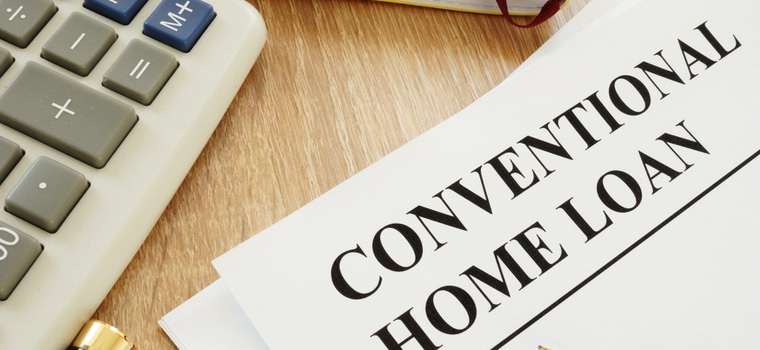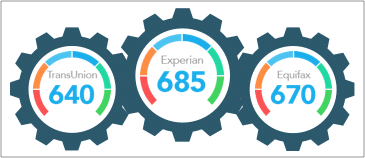A conventional loan is a mortgage offered by private lenders including banks, credit unions and mortgage companies. Because of this, they are not guaranteed by government agencies like the Federal Housing Administration (FHA) and the Department of Veterans Affairs (VA).
Conventional loans are more common than government-backed loans. In fact, conventional loans accounted for 74% of new mortgages during the first quarter of 2018.
If you’re in the market for a new home loan, it’s worthwhile to understand the different types of conventional loans and how they work as well as their benefits and downsides.
How Does a Conventional Loan Work?
In the early 2000s, “no-doc” and “no verification” loans were the rage. These terms refer to the fact that income, asset and employment verification were not required. These days, no-doc loans are mostly a thing of the past,
Currently, most of the basic mortgage loan requirements still exist for a conventional loan. You still have to fill out a loan application and supply supporting documents (bank statements, proof of income, etc.). Your lender will also want to see your credit scores and reports and they will likely require you to undergo a background investigation.
Conventional loans originate from the lender and include different terms depending on various factors such as your loan amount, down payment amount and credit score.
Conventional mortgage lenders offer fixed-rate mortgages for 15-year and 30-year terms. The annual percentage rate will stay the same throughout the duration of the loan.
The conventional loan marketplace also features adjustable-rate mortgages (ARMs) with varying terms. With an ARM, the rates are fixed during the early years of the term before converting to annually adjust to the market.
Lenders usually want a down payment of 10% to 20% for fixed-rate and adjustable-rate mortgages alike. In some cases, lenders will accept a down payment as low as 3% for qualified buyers. Just remember that if your down payment is less than 20% you may have to pay private mortgage insurance (PMI).
What Is the Difference Between a Conventional Loan and a Government-Backed Loan?
As you consider mortgage loan options, it’s helpful to know the difference between government-backed loans and conventional loans.
Government-Backed Loans
As the term suggests, government-backed loans provide a loan guarantee to the lender if you are unable to make payments.
For example, loans from the Federal Housing Administration (FHA) are designed for those with lower income. FHA loans require the borrower to pay a down payment of at least 3.5% and they include a mortgage insurance premium (MIP) in your monthly mortgage payment. If you were to default on the loan, the agency would use the MIP money to repay the lender.
Conventional Loans
Conventional loans differ from government-backed loans because the lender assumes all the risk if you default. As such, conventional loans don’t carry the same benefits that government-funded loans offer, such as lower credit score thresholds and lower down payment requirements.
If you stop making payments, the lender’s only recourse to recover their investment — or as much of it as they can — is by selling the property, possibly through a short sale or foreclosure.
What Are the Different Types of Conventional Loans?
Conventional loans come in many different flavors. The loan type which is best for you depends on your situation.
Conforming Loans
These mortgage loans are referred to as conforming because they adhere to the standards set forth by Fannie Mae and Freddie Mac.
That means conforming loans have a cap on the purchase price to meet government standards. The cap varies depending on your area but for most of the country, $510,400 is the current maximum loan amount. The maximum loan may be higher if you live in a high-cost area up to a maximum of $765,600 — which is 150% of $510,400.
Jumbo Conventional Loans
Jumbo loans are designed for those looking to purchase a home that exceeds the conforming loan limits. These non-conforming loans are typically funded by lenders or private institutions.
Jumbo loans are riskier because they are not backed by Fannie Mae or Freddie Mac. As such, these loans typically have higher interest rates and more stringent qualifying criteria than conforming loans.
Subprime Conventional Loans
If your credit is less than perfect, you might want to talk to a lender about subprime conventional loans. Typically, you’ll need a credit score of 620 or higher and a debt-to-income ratio below 50%.
Subprime loans are non-conforming so higher closing costs and interest rates may be in order. Still, they may provide a path to buying a home while you continue to build your credit.
Portfolio Conventional Loans
As its name suggests, these conforming loans remain in the lender’s portfolio instead of being sold to another mortgage loan institution.
The benefit of portfolio loans is that lenders usually have more underwriting flexibility to work with borrowers with low credit scores and higher debt-to-income ratios. With fewer restrictions to deal with, portfolio lenders can offer unique features to borrowers. For instance, the lender may let the borrower use investments as security for a loan for which they might not qualify otherwise.
However, these loans often carry higher interest rates and don’t include the level of consumer protections that are found in other conforming loans.
Conventional Amortized Loans
Amortized loans offer you a set monthly payment for the life of the loan. Since you pay the same amount of principal and interest every month, the last payment will pay off the loan with no need for a balloon payment.
Adjustable Conventional Loans
Unlike with amortized loans, the payments for adjustable-rate mortgage (ARM) loans can vary over the course of the loan term. Periodic adjustments to the interest rates are made to reflect the market.
Many adjustable conventional loans begin with fixed interest rates before converting to an ARM at a specific time. For example, a 5/1 ARM will begin as a fixed loan for five years, at which point it switches to become an adjustable-rate loan.
What Are the Benefits of Conventional Loans?
Conventional mortgages represent about two-thirds of all homeowner’s loans originating in the U.S. Lenders can offer more options with a conventional loan since they don’t have to confine their loans to fit within the government guidelines.
Conventional loans are popular because of the benefits they offer, including the following:
Low-Interest Rates
With conventional loans, a high credit score can help you secure a low-interest rate. In fact, the higher the score, the lower the interest rate on the loan. That’s because your credit score demonstrates your ability to repay a loan.
The lender may require a credit score of at least 620 to qualify. Borrowers with credit scores over 740 usually receive the most favorable terms.
Lower Mortgage Insurance
Mortgage insurance for conventional loans is often less than for non-conventional loans. That means you’ll save on mortgage insurance if you don’t have enough funds for a large down payment.
Also, you usually don’t have to carry private mortgage insurance (PMI) on your conventional loan once you have 20% equity in your home.
In contrast, FHA loans require you to pay 1.2% to 1.25% in annual mortgage insurance payments (MIP). In addition, you will also have to pay an upfront rate of 1.75% of the loan’s value, which is usually rolled into your monthly payment.
Loans Above the Property’s Value
Some conventional loans allow for financing above the value of the home. You can use the additional funds to furnish the home or for home improvements.
You will have to pay finance charges related to the mortgage, but you’ll be able to enjoy your new home without waiting to save money for furniture, repairs or upgrades.
Lending Flexibility
Because they don’t have to conform to the guidelines associated with government-backed loans, private mortgage lenders have more flexibility to relax common loan restrictions. Couple that with the fact that private lenders are incentivized to be flexible in order to attract your business in such a competitive marketplace.
As a result, you may be able to find a conventional loan with less stringent requirements. As such you might find favorable terms for the down payment (as low as 3% of the property’s purchase price), loan durations, credit scores and the like.
What Are the Downsides of Conventional Loans?
When you’re in the market for a new mortgage loan, you need to be aware of the disadvantages of some loans. Here are some common downsides you may run into.
Stricter Qualifying Requirements
Since government-backed loans reduce the risk for lenders, they are often easier to qualify for, so long as you are eligible.
On the other hand, conventional loan brokers may scrutinize your financial qualifications more closely since they are carrying more risk.
Higher Credit Score Needed
For a conventional loan, you’re most likely going to need a credit score of 620 or higher to qualify and at least 740 for a good rate. Conversely, you may be able to qualify for a government-backed FHA loan with a credit score as low as 500.
Requires Higher Down Payment
While you can finance a conventional loan with a down payment as low as 3%, you typically need a much higher down payment if you want to avoid paying private mortgage insurance. Higher down payments are also necessary to secure lower interest rates from the lender.
How to Qualify for a Conventional Loan?
The first step is to meet with a lender to determine which loan is best for you and what are the qualifying requirements. Here’s a brief look at the documentation most lenders want to review.
- Identification
Starting with the basics, your lender will want to copy your driver’s license or state ID card to verify your identity. Also, you’ll need to provide your Social Security number and a signature to authorize the lender to pull your credit report.
- Proof of Income
Lenders commonly request thirty days of pay stubs and your federal tax records and W-2’s for the past two years.
- Proof of Current Employment
Lenders prefer lending to borrowers with a steady work history. These institutions often call your current employer to verify your salary and that you are presently employed. They can even call past employers, especially if you recently changed jobs.
If you are self-employed, be prepared to show extensive paperwork detailing your business and how much you earn.
- Assets
In addition to proving your employment status and proof of income, you also need to show your current bank and investment account statements. The lender wants to see evidence you have funds to cover the down payment and closing costs and that you have readily-available cash reserves.
- Credit Score
A credit score of 620 or higher is usually required to get approved for a conforming conventional loan. In most instances, you’ll need a credit score of at least 740 to receive the best loan terms.
- Debt-to-Income Ratio
Another strong consideration for lenders is your debt-to-income ratio (DTI). In general, your total monthly debts should not exceed 36% of your monthly gross income.
Some lenders may make an exception and accept a DTI above 43% if your profile looks strong otherwise. For example, if you have a lot of assets, a strong credit score and a down payment of at least 20%, lenders may loosen their DTI guidelines.
The lender wants to see your documents to determine how much of a down payment you can offer. They also want to verify you have the assets to pay for all the up-front fees and the income to make monthly mortgage payments.
The Bottom Line
If you’re in the market to purchase a new home, it’s good to be familiar with conventional loans. They account for the majority of new home loans for good reason: lenders are not bound by the government guidelines for conforming loans so they can provide you with more flexibility.
You may be able to qualify for a loan amount higher than the value of the property in order to furnish the home or make improvements.
Also, your mortgage insurance may be less than it would with a government-backed loan. You could even eliminate PMI altogether if your down payment is at least 20% of the home’s value.
Check with a reputable mortgage broker to find out what loans are best for your financial situation.




